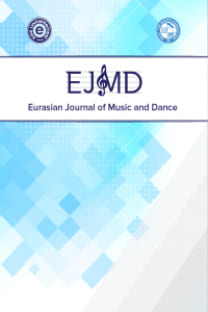GELENEKSEL TÜRK SANAT MÜZİĞİNDE MAKAM GEÇKİLERİ
Geçmişten günümüze gelen makam ve usul zenginlikleriyle Türk Müziği,
Anahtar Kelimeler:
geçki, geleneksel, makam, seyir, taksim
Maqam Modulations in Traditional Turkish Art Music
Turkish music has taken its place in the World music thanks to its richness ofmodal music and the rhythm which came from the past to present day. Thepitch system, which has been utilized in Turkish Music has further increasedthe modal liveliness. Considering the fact that 628 modes have been createdin Turkish music, it would not be wrong to discuss about an enriched form,which has constantly been developing between the past and the future. Inaddition to the abundance of the modes, the variety of tempo styles rangingfrom 2 to 128 intervals adds a distinctive richness to traditional Turkishmusic. For a mode to exists and be used by performers, many verbal andinstrumental works must be composed, as well as a sequence of compositions.The composers have composed works approximately in 100 modes and havepreferred to compose certain modes instead of the recently created ones. Inthe same work, however; they used the late technique and many of the sameauthorities at the same time. Most of the modes, which have not beenexercised in terms of repertoire, or have been composed scarcely any, hasfallen into oblivion. It is known and practiced by traditional musicalperformers that the tradition of intermodulation takes an important placeregarding performance. In addition to spontaneous compositions suchas taksim, na't, kaside and gazel, modulation among modes has been used inmost of the verbal and instrumental genres of traditional Turkish music.However, the absence of written sources other than a few short texts withregard to the teaching of modulation constitutes the problematic part of ourarticle. When the sources of Turkish music have been examined, it isunderstood once again that how much that issue has beenneglected. Composers have frequently used modulations intheir compositions to enhance their melodic liveliness and show their talentsas well. That tradition has reached the peak, especially in the form of karınatık as can be seen at Ahmet Avni Konuk’s “Rast Kar-Natık (Fihrist-Makamat)” with 119 different modes in it. The issue of modulation has alsobeen common among composers as well as instrumentalists. Especially in theform of taksim, modulation has been utilized widespread. Improvisations andmodulations during the intervals of suites, have the utmost importance inTurkish Music. The instrumentalists have demonstrated their skills by usingimprovisation by using modulation, while vocalists have demonstrated theirabilities by using freely performed genres such as gazel, kaside, na’t byutilizing modulation. This tradition continues today, although it has been lesswhen compared to the past.
Keywords:
Emprovisation melodic, development, mode, modulation, traditional,
___
- Akdoğu, Onur (1995). Türk Müziği'nde Türler ve Biçimler. İzmir: Can Ofset.
- Altınköprü, Halil (2017). Geleneksel Türk Sanat Musıkisinde Makam Geçkileri. İzmir: Ege Üniversitesi Rektörlüğü Basımevi.
- Arel, Hüseyin Sadeddin (1991). Türk Musıkisi Nazariyatı Dersleri. Yay. Haz: Onur Akdoğu. Kültür Bakanlığı Yayınları/1347. Kaynak Eserler Dizisi.
- Çelikkol, Erdinç (2000). Türk Musıkisi Bilgiler 1. Bursa: F. Özsan Matbaacılık Ltd. Şti.
- Ezgi, Suphi Ziya (1933). Nazari ve Ameli Türk Musikisi C.1-2. İstanbul: Milli Mecmua Matbaası.
- (1940). Nazari ve Ameli Türk Musikisi C.4-5. İstanbul: Alkaya Matbaası.
- Karadeniz, M. Ekrem (1965). Türk Musıkisinin Nazariye ve Esasları. İstanbul: Türkiye İş Bankası Kültür Yayınları.
- Özkan, İsmail Hakkı (1987). Türk Musikisi Nazariyatı ve Usulleri-Kudüm Velveleleri. İstanbul: Ötüken Neşriyat.
- Yavuzoğlu, Nail (2011). Türk Müziğinde Makamlar ve Seyir Özellikleri. İstanbul: Pan Yayıncılık.
- ISSN: 2651-4818
- Yayın Aralığı: Yılda 2 Sayı
- Başlangıç: 2011
- Yayıncı: Ege Üniversitesi
Sayıdaki Diğer Makaleler
GELENEKSEL TÜRK SANAT MÜZİĞİNDE MAKAM GEÇKİLERİ
RAKSTAN OYUNA Türkiye’de Dansın Modern Halleri
TÜRKİYE’DE MODERNLEŞME SÜRECİNİN MÜZİĞE YANSIMALARI BAĞLAMINDA “KLASİK KORO” ÖRNEĞİ
VİDEO OYUN MÜZİKLERİNİN ÜNİVERSİTE ÖĞRENCİLERİNİN DAVRANIŞLARINA ETKİSİNİN İNCELENMESİ
Uğur BAKAN, Mücahit Yalçin ÖZTÜFEKÇİ
İZMİR’DEKİ TÜRK SANAT MÜZİĞİ AMATÖR KOROLARININ İNSAN YAŞAMINDAKİ YERİ
SESTEN NOTAYA: SÛZİNÂK İLÂHÎ, “AŞKIN İLE ÂŞIKLAR” ÖRNEĞİ
9/8 ROMAN DANSI Kültür, Kimlik, Dönüşüm ve Yeniden İnşa
